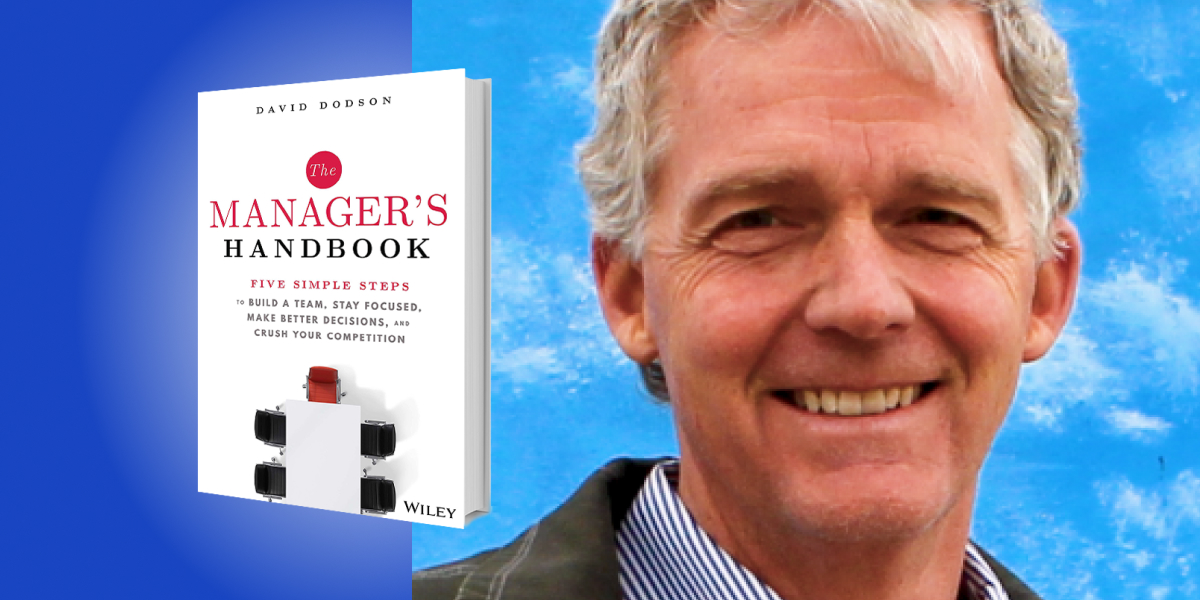David Dodson is on the faculty of Stanford University’s Graduate School of Business where he guides students in tactical execution. He is also a recipient of Stanford’s Distinguished Teaching Award. He is a frequent business commentator on CNBC and Fox News, and he has been published in the New York Times, Boston Globe, Fortune Magazine, Forbes, CNN, Business Insider, The Hill, and The Denver Post, among other publications.
Below, David shares five key insights from his new book, The Manager’s Handbook: Five Simple Steps to Build a Team, Stay Focused, Make Better Decisions, and Crush Your Competition. Listen to the audio version—read by David himself—in the Next Big Idea App.

1. Let’s debunk “attribute theory.”
The “attribute theory” is a way to explain why some people are inherently better than others, for example, better at getting things done. This theory, however, is simply not true. If you search on Google for a list of the attributes of entrepreneurs, you will find over 350 million results: creative, passionate, risk-tolerant, extrovert, introvert, good at public speaking, et cetera. None of these are universal characteristics that make effective leaders.
Those with these attributes are also great in sports, or lousy at sports, some are bipolar, some are geniuses, some went to Stanford, and some didn’t graduate from college. It’s a simplistic notion that effective leaders have to have certain attributes at birth, have a specific gender, look a certain way, or come from a particular school or zip code. Whilst specific attributes are not important, there are patterns to effective leaders, and these patterns are centered around skills.
2. Anyone can learn to be an effective leader.
Effective leaders do share expertise and excellence in five key skill areas, without exception. Their personality attributes can vary, but their command of these five skills never does. Be it Dwight Eisenhower, Martin Luther King Jr., Oprah Winfrey, or Bill Gates, they all have these five skills. This is significant because the key to effective managers is actually a set of management skills, not attributes awarded at birth. Therefore, becoming a leader is open to almost anyone.
Whether you want to send rockets into space or drill wells undersea, leaders share five common skill characteristics that can be learned and applied by anyone. These five skills of leadership are:
- a commitment to building a team
- being a fanatical custodian of time
- a willingness to seek and take advice
- setting and adhering to priorities
- an obsession with quality.
At Stanford, there are scores of theories, observations, and research reports that go nowhere; few change how people behave or manage. However, understanding these five skills could change the behavior of everyday managers.
3. The five skills of leadership all have sub-skills.
If you watch someone play the piano, watch the way their fingers move across the 88 keys. You will see that a pianist needs to combine a set of sub-skills in order to master the art of playing. For example, they need to know how to read music, how to position their fingers across the piano, and the difference between a sharp and a flat. It’s mastering these sub-skills, which are within most people’s abilities, that represent the difference between playing chopsticks, or Paul McCartney’s “Let It Be.”
In the same way, an effective leader needs to break each of the key five skills of leadership into easily accessible subs-skills. There is no shortcut; just like you can’t learn to play the piano without learning to read a sharp or a flat. You can’t build a team if you don’t know the sub-skills needed to do it.
4. The five skills of leadership are interrelated.
Professor Michael Porter of Harvard University has written 19 books on leadership, including the seminal piece on strategy and competitive strategy. Fortune magazine stated that he’s influenced more executives than any other business professor. He adds that the five skills of leadership are actually all interrelated. If a leader only picks certain skills or certain sub-skills and ignores the harder ones, they will continue to be ineffective. They must be seen as a unified principle of implementation: you can’t set and adhere to priorities if you’re not good at managing your own time, and you can’t achieve maximum quality, without a good team.
Despite starting over 50 years later, in one of the oldest businesses on the planet, Sam Walton did circles around JC Penney, Target, and Kmart. Not because Walton invented the department store, but because he hired better people. He maintained his focus, listened to advice, managed his time carefully, and was obsessed with quality and how his customers defined quality. You can’t reach your potential unless you’re willing to master all five of these skills, including the ones you don’t want to do. If all five skills come together, there will be turbocharging and they will be multiplicative.
“Jobs was masterful at building an entire organization that embraced the five skills of leadership.”
Apple recently became the first $3 trillion company, and Steve Jobs is commonly known for having a form of x-ray vision that combed technology with a view toward what consumers want. Yet, that wasn’t his primary superpower; it was that he has all five skills of leadership, and the commitment to insist on these practices throughout his organization. Jobs didn’t invent the portable computer; that honor falls to an unknown entrepreneur named Andrew Kay whose company K-Pro went bankrupt. The computer mouse was invented by Douglas Engelbart, who was working at the Stanford Research Institute. Sony created portable music, but Apple and IBM invented the smartphone. Jobs invented very little, and he uncovered few new markets. However, Jobs was masterful at building an entire organization that embraced the five skills of leadership. He’s not a savant or a genius, but the best example of a leader who brought together everything needed across the whole organization. The most admired companies and organizations apply these skills holistically and institutionally, and that is their superpower.
5. How to be an effective leader needs to be clearly stated and easily adopted.
The challenge now is to present this theory of effective leadership in a way that can be easily understood, and quickly, efficiently, and effectively mastered. The way we normally teach business skills, both in the classroom and on the bookshelf, is broken. For example, Harvard Business Review has written a piece on running a good management meeting that is 241 pages long.
There are entire books on running meetings, hiring, delegating, and time management, and the material is often good. However, who at those leading organizations has the time to read thousands of pages to get a dozen pages of usable content? What we need is a how-to manual, presenting vital information in the most efficient way possible.
To listen to the audio version read by author David Dodson, download the Next Big Idea App today:






























